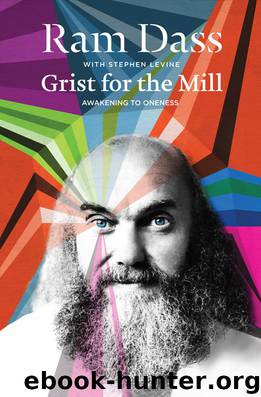Grist for the Mill by Ram Dass

Author:Ram Dass
Language: eng
Format: epub
Publisher: HarperCollins
Chapter 10
Freeing the Mind
Now we’re beginning to get a sense of the totality of the sadhana, the practice. We are working with the heart to open a flow with forms in the universe, including thoughts and emotions. That flow ultimately takes everything in form and converts it back into energy. We offer up stuff into the flow to get rid of it.
The offering up or the cleaning is called purification. It exists in every religion. In Raja Yoga these are the yamas, or it’s the various vows we take in Buddhism, or the abstinences and commandments in Christianity and Judaism. These are done out of what is called “discriminative awareness.” That is, we understand that we are entities passing through a life in which the entire life drama is a curriculum for our awakening. We see that the life experience is a vehicle for coming to God, for becoming conscious, for becoming liberated. And we understand that ultimately that’s what we’re doing here.
When we’re really wanting God, not just wanting to want God, we understand that is all we are doing here. When we are only wanting to want God, we say, “Well, I have this and that to do, but I’d like to live my life in order to return to God.” If we have studied the Four Noble Truths of Buddha, we’ve come to understand that the liberation from clinging and attachment is the liberation from suffering, and that liberates all beings from suffering. Or if we are thinking, Well, I can’t just want to go to God; I must help other human beings as well, we begin to see that these are not polarized, that these are very intimately integrated. Because every act we perform for other human beings can liberate them to the extent that we are liberated. If we feed someone with attachment, we fill his belly, but we also reinforce his attachments. And that reinforcement perpetuates his long-term suffering. Thus, ultimately, we understand that every act we do in life becomes an act of work on ourselves—because that is the highest thing we can do for all sentient beings, whether we’re feeding somebody, or sitting in a cave meditating, or making people laugh, or providing a service or goods, or making a sandal. Whatever we’re doing, we’re a transmission of our being.
For instance, the image we have of musicians is of entertainers: someone playing music for other people to hear. As we begin more clearly to hear what the dance is about, we understand we are souls on the journey toward our own liberation, and everything is grist for the mill, including our flutes and our flute-playing. Then we are doing what the Bhagavad Gita talks about; we are playing the flute as an offering to God. So we’re playing it back into the circle. And as we use the flute-playing as an act of purification, it’s no longer “my” flute, and it’s not played for ego gratification. It’s part of sadhana; it’s an offering—the whole process is an offering.
Download
This site does not store any files on its server. We only index and link to content provided by other sites. Please contact the content providers to delete copyright contents if any and email us, we'll remove relevant links or contents immediately.
Rewire Your Anxious Brain by Catherine M. Pittman(18282)
Talking to Strangers by Malcolm Gladwell(12864)
The Art of Thinking Clearly by Rolf Dobelli(9908)
Mindhunter: Inside the FBI's Elite Serial Crime Unit by John E. Douglas & Mark Olshaker(8697)
Becoming Supernatural by Dr. Joe Dispenza(7831)
Change Your Questions, Change Your Life by Marilee Adams(7369)
The Road Less Traveled by M. Scott Peck(7274)
Nudge - Improving Decisions about Health, Wealth, and Happiness by Thaler Sunstein(7238)
The Lost Art of Listening by Michael P. Nichols(7157)
Mastermind: How to Think Like Sherlock Holmes by Maria Konnikova(6935)
Enlightenment Now: The Case for Reason, Science, Humanism, and Progress by Steven Pinker(6869)
Win Bigly by Scott Adams(6823)
The Way of Zen by Alan W. Watts(6288)
Daring Greatly by Brene Brown(6221)
Big Magic: Creative Living Beyond Fear by Elizabeth Gilbert(5348)
Grit by Angela Duckworth(5295)
Men In Love by Nancy Friday(4963)
Ego Is the Enemy by Ryan Holiday(4950)
Altered Sensations by David Pantalony(4863)
